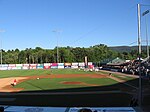American Geophysical Union v. Texaco, Inc.

American Geophysical Union v. Texaco, Inc., 60 F.3d 913, was a 1995 U.S. copyright case holding that a private, for-profit corporate library could not rely on fair use in systematically making copies of articles in academic journals for its employees. A divided panel of the U.S. Court of Appeals for the Second Circuit affirmed a ruling by Judge Pierre Leval of the U.S. District Court for the Southern District of New York in favor of the academic publishers who had filed the lawsuit. The case was the first heard by the Second Circuit to seriously consider the question of transformative use, a concept Leval had introduced, in evaluating a fair use claim.In the wake of an earlier case that had held similar archival photocopying of academic articles by a government agency's internal library to be fair use due to the public purpose of the agency, Congress had urged the academic publishing industry to develop ways to adequately license such photocopying, a common practice, by private, for-profit libraries. One such system was in place during the 1980s, but Texaco declined to use it, citing its cumbersome bureaucratic requirements and its belief that the practice was fair use, leading several academic publishers, including the American Geophysical Union (AGU), to sue for copyright infringement. At trial Leval found that Texaco's fair use defense failed on three of the four factors used to determine fair use. The copies were used for the same informational purpose as the original articles, and Leval did not find that the ability they gave the scientists to bring them into the lab or home was sufficiently transformative. The articles were copied in their entirety and adversely affected commercial opportunities for the publishers in the form of the lost revenue they otherwise would have made from licensing the photocopying and/or the sale of additional subscriptions to their journals. Only on the second factor, the purpose of the work, did Leval hold for Texaco, since both the originals and the copies were used commercially. Two years later, the Second Circuit took into account the Supreme Court's Campbell v. Acuff-Rose Music, Inc. decision in the interim, which had recognized transformative use when it held parody to be protected under fair use. Judge Jon O. Newman's majority opinion, amended twice over the year following, criticized Leval for having emphasized Texaco's commercial purpose, and held that the second-factor test, the purpose of the work, favored neither side, but otherwise affirmed his holding. Judge Dennis Jacobs dissented, arguing that the use of the photocopied articles was indeed transformative since ultimately they could lead to new research and new ideas, as well as attacking as "circular" the majority's lost revenue finding when the entire purpose of the case was to determine whether the use that gave rise to those revenues was fair, themes echoed in criticisms by academic commentators. After further appeals were denied, Texaco settled the case.
Excerpt from the Wikipedia article American Geophysical Union v. Texaco, Inc. (License: CC BY-SA 3.0, Authors, Images).American Geophysical Union v. Texaco, Inc.
School Street,
Geographical coordinates (GPS) Address Nearby Places Show on map
Geographical coordinates (GPS)
| Latitude | Longitude |
|---|---|
| N 41.5186 ° | E -73.9373 ° |
Address
School Street
School Street
12527
New York, United States
Open on Google Maps




